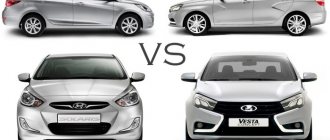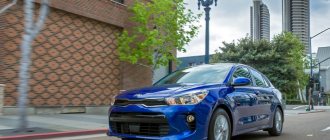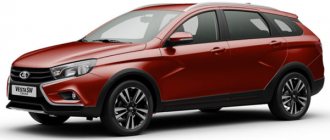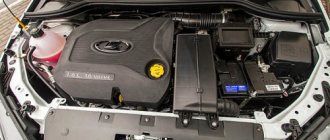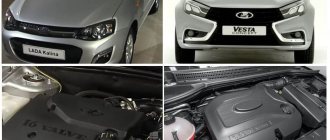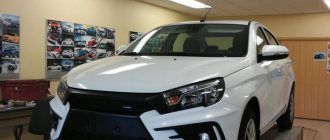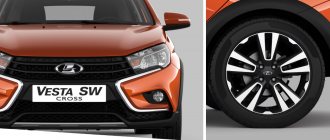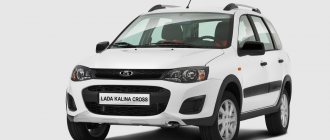Having appeared in AvtoVAZ showrooms, the Lada Vesta SV Cross lured away, or even took away the share of buyers of the Creta crossover from the Korean SUV Hyundai Creta. The decent appearance and excellent characteristics of both cars made buyers think about the choice for or against. Lada vesta sw cross takes the cake with its design. Hyundai Creta with a more powerful engine. The price for vesta sw cross starts from 745900 to 841900. Creta from 922000 to 1300000.
Comparing two cars will allow doubting car enthusiasts to choose. Read the article and resolve this agony of choice. So Korean Creta vs Russian Vesta St. cross!
Comparison of bodies and wheelbases
General dimensions of a Korean car:
- 4.270 x 1.780 x 1.63 m;
- Base - 2,590 m;
- Ground clearance - 0.19 m.
The first copies of Korean cars sold had problems with paintwork. According to manufacturers' assurances, the problem with coating destruction has been resolved in current production vehicles. Galvanized steel sheets with a guaranteed anti-rust coating are used for the body of the Creta. The height of the metal section is from 0.6 - 0.8 mm. Build quality is generally okay.
Results
So, urban crossover or elevated station wagon? We think to each his own. Buyers (or rather, customers) of the Hyundai Creta probably appreciate it for the same level of quality, which is expressed in the nuances of the interior assembly, in the design, and in the driving settings. You can call the Creta boring or expensive, but it's not bad. An excellently balanced car.
And Lada is completely different. More lively, cocky, gambling, but at the same time a little rougher both in finishing and in driving performance. But it has more ground clearance, incredibly “armor-piercing” suspension and a more practical trunk. And price, of course, plays a decisive role. Therefore, to each his own: it is unlikely that buyers of the Lada Vesta SW Cross and Hyundai Creta consider them as rivals. But we also have a great future for Vesta SW.
Or log in using one of the services
Published by Dex, September 20, 2017
General characteristics of the Vesta SW Cross station wagon:
- 4.424 x 1.785 x 1.532 m;
- base - 2.635 m;
- Ground clearance - 0.203 m.
The ground clearance is greater than that of the Hyundai Creta SUV. Body type - station wagon, five doors. Vesta's paintwork is done conscientiously, smoothly, and durable. The metal body of the Lada is galvanized on the outside. Zinc coating is applied using a cold process. The assembly of the car does not cause any complaints from car owners. The horizontal dimensions of the cars are approximately equal, and the height is more spacious than the Creta. LKP wins over Vesta. Hyundai Creta has the best metal protection.
Off-road? Let's try
Although both cars boast “cross” genes, in real life front-wheel drive significantly limits off-road capabilities. It remains to evaluate the operation of the traction control electronics and the geometric parameters of cross-country ability.
In terms of ground clearance, the Lada Vesta SW Cross wins, offering 203 mm. Hyundai Creta is a little closer to the ground - 190 mm. When trying to drive a ditch “diagonally”, with one of the drive wheels hanging out, the Lada Vesta SW Cross tried to imitate a differential lock, but it remained an imitation. Vesta never moved forward. But she managed to get back on her own.
The Hyundai Creta, following the rut rolled out by Vesta, was able to slip through the ditch from acceleration, but if you stop at the moment when the drive wheel is unloaded, the Creta will not go anywhere, it will helplessly grind the air with the hanging wheel.
Salon battle
The interior of the Creta car surprises with its modesty, thoroughness, and practicality. Hard plastic of different textures looks good. The front door handles are solid, comfortable, and look great. A convenient button adjusts the level of heating of the front seats. With the maximum range of options, rear row passengers can also warm up. Adjusting the seats vertically and horizontally will prevent you from getting tired on the road. Oversized mirrors provide an excellent view of the road. The Creta is fully equipped with a rear view camera. The steering wheel is covered with soft, pleasant-to-touch leather. There is a display with the necessary information. Driver/front passenger front airbags provide safety as standard. The Travel modification adds side airbags. The car is equipped with a cruise control system. The main advantage of the Huyndai Creta interior is its free seating. There is enough space in front and above your head.
The interior design of Vesta SW Cross does not surprise with new discoveries; everything is familiar from previous versions. Red inserts on a black background of hard plastic dilute the strict interior design. Comfortable seat shape, three levels of heating. Optimal amplitude of seat displacement. The rear seat will please tall subjects. A center armrest, heated seats, and a charger for mobile phones will add a good mood to the second row of passengers. The on-board computer with a colorful display has many useful functions that are missing even in expensive cars. Vesta Cross is equipped with a cruise control system, which is very convenient on long trips. In terms of the quality of materials and interior design style, Vesta is, of course, inferior to the Korean Creta. But it has a multimedia system, more comfortable seats, and a heated windshield.
In terms of driving safety in the cabin, the Creta is in the lead, and in terms of heated seats and their adjustment - complete parity.
Both cars offer a spacious interior for five people.
Interior
Both cars are good inside, so it’s difficult to determine which is better – X-Ray or Creta. To a large extent, it all depends on personal preference. The LADA XRAY salon as a whole continues its cocky exterior style. In front of the driver there are deep wells in which the instruments are hidden, and in front of them there is a 3-spoke sports steering wheel.
The design of the dashboard is very successful, without breakable elements, and the ergonomics are well thought out, and the center console is decorated with a large display. The finishing materials, of course, are not standard, but they are quite high quality, and the assembly is at the same level.
The interior of the Hyundai Creta is made in a slightly different style. Everything here is more formal, as is the appearance, which is why some people find this interior style too bland.
A massive dashboard, made of plain black plastic and diluted with metal-look inserts on the steering wheel, air deflectors and near the gearbox selector, hangs over the passengers. As in the X-Ray, there are no problems with ergonomics, and information from the instrument panel is easy to read.
A clear comparison of Hyundai Creta vs Lada X-Ray is demonstrated in the video
Engine characteristics and fuel consumption.
In different configurations, the Hyundai Creta is equipped with 2 gasoline engines of 1.6 and 2 liters, with a power of 123 and 149 hp. The 1.6-liter engine accelerates the car to 100 km/h in 12 seconds, consuming 7.1 liters of gasoline, the 2-liter engine reaches the same speed in 11 seconds, consuming 7.8 liters of fuel. Vehicle weight - 1472 kg. Both engines are reliable and have good dynamics. The manufacturer claims a range of 200,000 km.
Advantages and disadvantages of 1.6:
- excellent dynamics;
- lower fuel consumption than the 2 liter version;
- reduces the cost of the car.
A more powerful version of the Creta engine allows you to feel confident when overtaking in high-speed highway conditions. At the same time, choosing a 2L unit will entail higher gasoline consumption and an addition to the price of the car.
Maximum speed – 183 km/h.
Gasoline brand - 92 and higher.
Vesta station wagon engines are 1.6 liters with a power of 106 hp, 1.8 liters with a power of 122 hp. in conjunction with a 5-speed manual transmission and a 5AMT robot. The 1.8 liter Lada is equipped with both a robot and mechanics. 1.6 liter - only manual. Gasoline grade - minimum 92.
Maximum speed -181 km.
Acceleration time to one hundred kilometers and corresponding fuel consumption in the combined cycle:
- 1.6l – 106 hp – 12.6 sec., – 7.5 l;
- 1.8l - 122 hp – 11.2 sec., 5MT – 7.9 l;
- 1.8l - 122 hp – 13.3 sec., 5AMT – 7.7 l.
Vehicle weight - 1300-1350 kg.
Users consider Vesta Cross optimal, which has a 1.8-liter engine with a manual transmission. Cretta's two-liter engine is essentially an improved version of a less powerful unit. It has more power, a confident and smooth ride.
In terms of power it is ahead of the Hyundai Creta, and in terms of gas consumption it is approximately equal.
HYUNDAI CRETA - LADA XRAY
Specifications
| COMMON DATA | Hyundai Creta | Lada Xray |
| Dimensions, mm: length / width / height / base | 4270 / 1780 / 1630 / 2590 | 4165 / 1764 / 1570 / 2592 |
| Ground clearance, mm | 190 | 195 |
| Trunk volume, l | 402 / 1396 | 361 / 1207 |
| Turning radius, m | 5,3 | n.d. |
| Curb / gross weight, kg | 1345 / 1795 | 1250 / 1650 |
| Acceleration time 0 - 100 km/h, s | 12,3 | 10,9 |
| Maximum speed, km/h | 169 | 186 |
| Fuel / fuel reserve, l | A92/55 | A92 - A98 / 50 |
| Fuel consumption: urban/suburban/combined cycle, l/100 km | 9,0 / 5,8 / 7,0 | 8,6 / 5,8 / 6,8 |
| CO2 emissions, g/km | 161 | n.d. |
| ENGINE | ||
| Location | Front transverse | Front transverse |
| Configuration / number of valves | P4/16 | P4/16 |
| Working volume, cubic meters cm | 1591 | 1774 |
| Power, kW/hp | 90.2 / 123 at 6300 rpm. | 90 / 122 at 6050 rpm. |
| Torque, Nm | 150.7 at 4850 rpm. | 170 at 3700 rpm. |
| TRANSMISSION | ||
| Type | front-wheel drive | front-wheel drive |
| Transmission | M6 | P5 |
| CHASSIS | ||
| Suspension: front/rear | McPherson / elastic beam | McPherson / elastic beam |
| Steering | rack and pinion with hydraulic booster | rack and pinion with electric booster |
| Brakes: front / rear | ventilated disc / disc | ventilated disc / drum |
| Tire size | 205/65R16 | 205/55R16 |
Machine warranty
Warranty obligations of a new Korean car are accompanied by a five-year manufacturer's warranty, or a mileage of 150,000 km. Warranty repairs are only possible if the machine is used correctly and undergoes timely maintenance. The same period has been established for eliminating paintwork defects. Some parts are guaranteed for a year or 20,000 km. AvtoVAZ gives its Lada a six-year or 100,000 km warranty.
Exterior
The appearance of the Asian SUV is not distinguished by sophistication. The angular shape makes it bulky. Creta is several years younger than Vesta, so in 2022 it had to undergo a restyling. The recognizable Hyundai style has been preserved. Main changes:
- The radiator grille has a honeycomb structure instead of horizontal stripes.
- More dynamic lines of bumpers and optics.
- New design of alloy wheels.
- Option of a completely black roof.
- LED daytime running lights.
- Illumination when turning.
- Projection lighting on the doors.
Gretta's color scheme consists of eight colors:
- white,
- red,
- brown.
- black,
- silver,
- dark grey,
- blue,
- light grey.
The first of them from official dealers is basic and free; choosing any other will cost 6,000 rubles, and from some dealers 12,000.
The lower part of the body along the perimeter is protected by a plastic body kit, which is a traditional attribute of an SUV.
Vesta's appearance turned out to be more aggressive. The characteristic X-shaped stampings on the doors make the car's profile unambiguously recognizable. The front part of the body is also designed in the corporate style of the modern Lada model range. The gaps between body elements are minimal.
The protective body kit looks good, fitting tightly and evenly to the body. The wheel arches are equipped with felt fender liners. The streamlined antenna, low roof rails and a spoiler in continuation of the roof line of the SV version give its outline a swift appearance.
Lada has a wide selection of colors - 10 are offered versus 8 from the Korean competitor. This is achieved through a greater number of shades of black and gray. The SW station wagon looks more massive than the sedan due to its long sidewall, large glass area and narrow rear window.
Disadvantages include poor rear visibility, as well as the absence of a rubber seal along the perimeter of the inner edge of the front door (it is only available above the glass).
Price for minimum and maximum configurations
The cost of the Hyundai Creta 1.6L 6MT 2WD in the smallest Start configuration is 879,900 rubles. Even in basic equipment, the Creta has front airbags for the driver and front passenger. The price of a fully equipped Hyundai Creta Travel with a two-liter engine and automatic transmission is set at 1,307,900 rubles.
Not a big price for Ladas in the initial configuration: they are equipped with a 1.6 liter engine and a manual transmission. The price with a minimum configuration is 770,900 rubles. With a full load of options and a 1.8 liter engine, the price of Vesta increases to 866,900 rubles.
Technical specifications
At the time of the release of the Vesta SV Cross, many people very animatedly discussed the lack of all-wheel drive. Like, what kind of crossover is this if it is only available with front-wheel drive? And it seems that at first the plant gave some hope for the appearance of all-wheel drive, but then they completely abandoned their words, arguing that this was due to serious investments in the design of the machine and the restructuring of the conveyor line. In short, you shouldn’t expect all-wheel drive on the Vesta SV Cross in the near future. The Hyundai Creta has all-wheel drive and there are absolutely no problems with it. Take it and use it. Of course, the Creta is far from being a frame SUV, as we would like to see it, but an ordinary city crossover that can be driven off the road quite a bit. Most likely, the Vesta SV Cross will behave in approximately the same way, even with front-wheel drive.
Availability of automatic transmission. Now the only automatic transmission on the Vesta SV Cross is AMT (robot). This is not the most successful transmission and many people frankly spit after driving it. AvtoVAZ engineers have made a new firmware for the robot. And supposedly it began to work better, but still, even for a classic machine gun, it’s so far off. And only versions with a 1.8L engine have a re-flashed robot. And the Creta has an automatic transmission. Quite reliable, smooth, good and proven automatic. Ground clearance. Since we are talking about crossovers, it would be stupid not to mention ground clearance. The Creta's ground clearance is 190 mm according to the passport (in reality 170 mm), and the Vesta SV Cross is 200 mm (in reality 20 mm). Here Vesta definitely wins.
As for the engines, in the basic versions both cars are equipped with 1.6L engines. Only in Vesta it produces 106 hp, and in Creta - 123 horses. Although in terms of acceleration, both engines are approximately the same: 11.6 seconds to hundreds for Vesta and 11.3 seconds for Creta. On the highway, the cars will behave approximately the same. More advanced versions have more powerful engines - 1.8 l and 122 hp for Vesta and 2.0 l 150 hp. at Crete's.
The luggage compartment of the SV Cross is much larger and more spacious - 480 liters versus 402. Vesta’s presence of all kinds of drawers and compartments for storing things is also captivating. In this case, it will not be difficult to determine the winner.
Trunk
The cargo capacity of the Hyundai Creta is 402 liters. The folded parts of the rear seats end up on the level of the trunk floor. This allows you to transport long items, the useful volume increases to 1.28 cubic meters. m. A pleasant discovery awaits you in the luggage compartment. Behind the double bottom there is an additional removable shelf with a full spare tire and tools. Removing the shelf with the wheel significantly increases the capacity of the cargo niche. Both trunk compartments are lined with sound-proofing materials.
The trunk of the Vesta Cross with 480 liters of volume can easily accommodate three suitcases. The door can be conveniently closed using two handles. Compartments are designed for containers and necessary things. The raised floor with spare wheel, nets and recesses increases the capacity of the luggage compartment by another 95 liters. With the flat design of the rear sofa, the trunk capacity doubles to 875 liters.
In terms of cargo transportation, Vesta Cross is in the lead, but with the supports of the salon furniture removed, Creta quickly pulls ahead.
Who's going how?
Calmness and tranquility - this can be said about both the design of the Hyundai Creta and its driving performance. Absolutely “even” impressions, everything is at a decent level, and there are no obvious shortcomings. Maybe we would like the acceleration to be a little quicker, and the sound insulation to be a little better, but everything else suits us as is. Huge mirrors, comfortable seating, sufficient dynamics. It steers pleasantly, does not irritate with harshness or rolliness, and absorbs spring potholes well.
The Creta's suspension settings are still closer to asphalt. I don’t really want to hit the primer with all my money
Although if the road becomes frankly bad, it is better to reduce the speed - there is no large reserve of energy capacity in the suspensions. In general, a good city crossover, without enthusiasm or disappointment. Apparently, such balance is the secret of Creta’s good sales, because absolutely everyone can like it.
Lada suspensions perform best on dirt roads, but on asphalt the Cross is a little harsh
When you change into a Lada, you immediately notice that its character is completely different. A sharper steering wheel, long-travel suspensions, clearly tuned with a “cross” aim, a more torquey 1.8-liter engine - it evokes more emotions. But not all of them are positive: the engine sound is harsher, rougher, and attracts attention. The gearbox lacks the crispness that the Creta enjoys. And the seats with colorful inserts are less comfortable.
Vesta SW Cross is tuned for truly bad roads - the energy intensity of the suspension is amazing
But if you don’t compare and just test the Cross, then, although it seems a little stiff on a good track, it very pleasantly surprises you on a country road or broken asphalt. Despite the 17-wheel drive with a relatively low profile, the suspension simply encourages you to jump over potholes without letting off the gas. And it turns out so easy that you gradually start driving in this mode - Cross encourages you!
Box
All modifications of Hyundai Creta are equipped with front-wheel drive. A six-speed manual transmission of the M6СF1 series is installed only with a 1.6-liter engine. The Korean mechanics are highly stable. The automatic transmission of the Hyundai Creta has six gear stages. The main values of the Creta automatic transmission are:
- Longevity;
- Exceptional dynamics;
- Low fuel consumption.
All-wheel drive is a privilege of a car with a two-liter engine. The rear multi-link transmission helps the Creta move confidently on any road, accurately take turns, maintain direction, and not sway when driving over bumps and ruts.
The Creta with front-wheel drive is less stable when driving in a straight line and avoids curves worse. Rear suspension lacks energy. She goes through pits and slides with less diligence.
Lada Vesta Cross leaves the factory with two transmission devices: 5MKPP, Robot - 5AMT. A robotic gearbox is an average version between an automatic transmission and a manual transmission. With AMT, there is no need for warming up.
Mechanical disadvantages:
- slowness;
- lack of smooth switching.
Mechanical advantages:
- reliability;
- cheaper than a machine gun;
- protection against switching errors.
- The 5th manual transmission comes with 1.6l and 1.8l Vesta engines.
Advantages of the AMT box:
- speeds switch smoothly;
- good dynamics;
- affordable price;
- faint noise.
Appearance
Here I would like to remain silent altogether, since, as they say, all markers are different in taste and color... In the case of Vesta SV Cross and Creta, everything is exactly the same. The Creta is made in a modern Asian style - sloping body lines, stretched headlights, a massive radiator grille. In general, everything that is typical of a modern crossover. Vesta SV Cross, on the contrary, is made in the now fashionable X-design. ICS can be traced almost everywhere. Personally, it seems to me that the face of the car is a little reminiscent of modern Lexuses... But this is just my association. Yeah, the Lada Vesta SV Cross certainly doesn’t lack for charisma. I would also like to note that both cars have a plastic protective body kit made of black plastic.
What to choose
The advantage of the Lada is its true versatility, as well as its powerful suspension. And all this for an affordable price. The combination of these factors is to the liking of people of any age.
But due to the bold design, there are more fans of Russian cars - after all, among young people. The main drawback is the lack of all-wheel drive modification.
The Creta has a wider choice of engines, a reliable and predictable design, and most importantly, an all-wheel drive option, which, however, does not make it an SUV. A definite plus is the larger interior volume.
All these advantages more than offset the frankly boring design. Thus, the car is suitable for those who are willing to overpay a little for the brand.
Bottom line: choosing any of the options considered will not be unsuccessful. Both cars have proven themselves well in the market, as evidenced by their leading positions in sales rankings.
